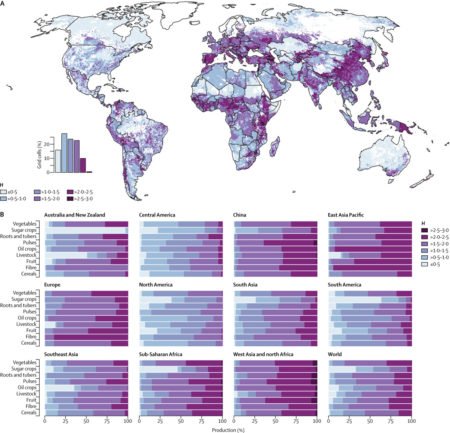- Participate!
- In plant breeding, that is.
- And seed systems too, natch.
- And you too could come up with the world’s hottest pepper.
- Or help save a heritage breed.
- Or sustainably harvest Himalayan nettle.
- But careful not to get high on this chocolate hack.
- Though binging on avocado is perfectly acceptable.
- And for goodness’ sake, watch out for those Russians.
Brainfood: CWR use, Mainstreaming, Duplicates, Phaseolus model, Cherimoya diversity, Legume mixtures, ICRISAT pearl millet, Taste breeding, Rhubarb rhubarb, Plasticity, Seed dispersal
- The Use of Crop Wild Relatives in Maize and Sunflower Breeding. In maize, unlike sunflower, it just hasn’t been worth it. Yet.
- Securing sustainable and nutritious food systems through mainstreaming agricultural biodiversity: an interdisciplinary study. What works in Brazil won’t necessarily fly in India.
- Duplication assessments in Brassica vegetable accessions. Half of 13 accession pairs/triplets with identical names from VIR and NordGen turned out to be morphologically identical.
- Beans (Phaseolus ssp.) as a Model for Understanding Crop Evolution. 7 independent domestication “events” spread across 5 species and 2 continents makes for some interesting natural experiments.
- A Mesoamerican origin of cherimoya (Annona cherimola Mill.). Implications for the conservation of plant genetic resources. Compare and contrast with above.
- Highly productive forage legume stands show no positive biodiversity effect on yield and N2-fixation. Sometimes diversity doesn’t add much.
- Genetic Resources of Pearl Millet: Status and Utilization. 22,888 accessions from 51 countries. Indian landraces: earliness, high tillering, high harvest index and local adaptation; African: bigger panicles, large seed size, and disease resistance.
- Use of natural diversity and biotechnology to increase the quality and nutritional content of tomato and grape. Both are needed.
- Rhubarb (Rheum species): the role of Edinburgh in its cultivation and development. From China, via Russia, with love.
- Will phenotypic plasticity affecting flowering phenology keep pace with climate change? If the change is smaller than about 13 days.
- Seed dispersers help plants to escape global warming. Because they move seed >35 m per decade uphill.
Kew helping protect your morning joe
Remember a short blog post from seven years back saying how Ethiopia had just protected some wild coffee forests?
We Nibbled yesterday a UN press release saying that a Biosphere Reserve had been created in Ethiopia to protect wild coffee. But actually it turns out that it is no less than TWO reserves that have just been selected by UNESCO, Kafa and Yayu. Many thanks to Tadesse Woldemariam Gole for the tip.
No, I didn’t think so. But anyway, here’s the latest on that, courtesy of the coffee team at Kew.
In April 2015 we started the three year project ‘Mainstreaming biodiversity conservation and climate resilience at Yayu Biosphere Reserve (Ethiopia)’. In this project, poverty alleviation, biodiversity, and climate resilience, are inextricably linked.
…
The project has now been running for almost two years, and despite a few surprises, is achieving considerable success. Catch-up on our progress in the second part of this post, available in the coming months.
Previous experience in this sort of thing has been mixed, so I’m looking forward to hearing more. In the coming months.
Nibbles: Rice in Trinidad, Sweet potatoes in Ethiopia, EU crop diversity double, Sir Peter on the ginkgo, Forages, Brazilian peanuts, Seed moisture, Phenotyping double, Svalbard deposit, CATIE data, Herbarium double, Seed #resistance, Father of the apple, Agave congress
- African rice out of Africa, and out of the genebank.
- The other way around for sweet potato.
- Markers for micronutrients. And diversity for taste…
- The deep history of the ginkgo.
- Study plants to decrease the effects of burping.
- Brazil rationalizes peanut collections.
- Measuring moisture in seeds.
- Big data for better seeds. And not only in Iowa.
- NZ seeds in Svalbard.
- CATIE on Genesys.
- Oz biosecurity fail. Better stick to online.
- I want to be a seed rebel too.
- Maybe in Kazakhstan?
- Agave under the volcano under the cosh.
Smaller farms, more crop diversity, more nutrients, mainly
There’s a follow-up to that Environment Reports website on farm size and nutrient production that we blogged about a couple of weeks back. The data come mainly (though not exclusively) from a blockbuster inaugural Lancet Planetary Health article.
The new website explores farm size variation among different regions of the world through some great imagery. But it also highlights one aspect of the paper that I didn’t mention in the previous post: crop diversity on farm. Here’s the relevant figure (the paper’s figure 5), mapping how many different types of crops are produced in a pixel and how evenly these different types are distributed (the Shannon diversity index, H).
Here’s what the authors have to say about diversity and nutrient production (my emphasis).
…combining the diversity measures with spatially explicit plot sizes, which are highly correlated with farm size, shows that agricultural diversity (H) decreases as plot size increases (p<0·0001; appendix). In particular, areas with small and medium farms (≤50 ha) have larger diversity than do larger scale farms. These differences also translate into differences in nutrient production (figure 6). On a global level, areas with higher diversity of food commodities (higher H) produce more micronutrients than do areas with less diversity. This effect is particularly noticeable in places such as China, sub-Saharan Africa, east Asia Pacific, and west Asia and north Africa. In contrast with North America, in Europe, although production comes mostly from medium and large farms, it is not farm size, but the diversity of production that drives nutrient production in this region.
